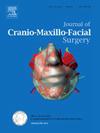用新颖的数字工作流程评估正颌手术后三维软组织变化和预测硬组织变化。
IF 2.1
2区 医学
Q2 DENTISTRY, ORAL SURGERY & MEDICINE
引用次数: 0
摘要
为了研究三维硬软组织虚拟手术计划在正颌手术中的应用,我们前瞻性地纳入了来自两家私人口腔外科诊所的21名连续治疗的患者。使用Artec Space Spider进行软组织面部扫描,并在手术前1个月(T0)、术后2个月(T1)和6个月(T2)进行口腔内扫描。在T0和T1采集锥束计算机断层扫描(CBCT)。通过在Geomagic Control x中叠加扫描来评估一系列三维软硬组织变化。将获得的硬组织变化与术前预测进行比较。还分析了固定矫治器与Invisalign®治疗患者软硬组织变化的差异。Artec Space Spider被证明是虚拟手术计划的新型数字工作流程的可靠组成部分,具有可重复性和再现性。在T1和T2之间,上颌和下颌区域均观察到临床上明显的软组织复发。硬组织地标的预测手术运动显示出很高的准确性,T1时软硬组织变化率与文献中报道的二维数据一致。在固定矫治器和Invisalign®之间没有发现软组织或硬组织变化的显著差异。这些发现为加强手术计划和改善临床医生和患者的临床结果提供了有价值的见解。本文章由计算机程序翻译,如有差异,请以英文原文为准。
Assessing three-dimensional soft tissue changes and the prediction of hard tissue changes after orthognathic surgery with a novel digital workflow
To investigate the application of three-dimensional hard and soft tissue virtual surgical planning in orthognathic surgery using a novel digital workflow, we prospectively included twenty-one consecutively treated patients from two private oral surgery practices. Soft tissue facial scans were acquired using the Artec Space Spider, and intra-oral scans were obtained at one month before (T0), and at two (T1) and six months (T2) post-surgery. Cone-beam computed tomography (CBCT) scans were collected at T0 and T1. Serial three-dimensional soft and hard tissue changes were assessed by superimposing the scans in Geomagic Control X. Achieved hard tissue changes were compared to pre-surgical predictions. Differences in soft and hard tissue changes between patients treated with fixed appliances versus Invisalign® were also analyzed. The Artec Space Spider proved to be a reliable component of a novel digital workflow for virtual surgical planning, demonstrating repeatability and reproducibility. Clinically significant soft tissue relapse was observed in both the maxillary and mandibular regions between T1 and T2. Predicted surgical movements for hard tissue landmarks showed high accuracy, and soft-to-hard tissue change ratios at T1 aligned with two-dimensional data reported in the literature. No significant differences in soft or hard tissue changes were found between fixed appliances and Invisalign®. These findings provide valuable insights for enhancing surgical planning and improving clinical outcomes for both clinicians and patients.
求助全文
通过发布文献求助,成功后即可免费获取论文全文。
去求助
来源期刊
CiteScore
5.20
自引率
22.60%
发文量
117
审稿时长
70 days
期刊介绍:
The Journal of Cranio-Maxillofacial Surgery publishes articles covering all aspects of surgery of the head, face and jaw. Specific topics covered recently have included:
• Distraction osteogenesis
• Synthetic bone substitutes
• Fibroblast growth factors
• Fetal wound healing
• Skull base surgery
• Computer-assisted surgery
• Vascularized bone grafts

 求助内容:
求助内容: 应助结果提醒方式:
应助结果提醒方式:


